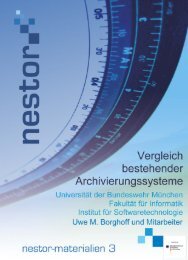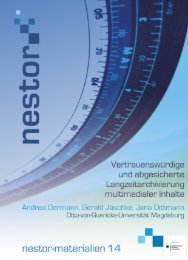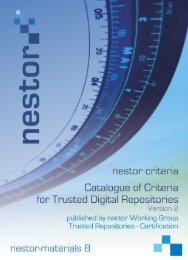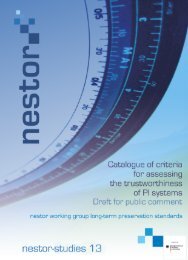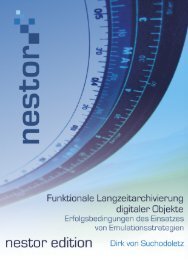It is with this step that the metadata information (with the exception of certain DescriptiveMetadata) for the Archival Information Package must be generated or assembled in thecorrect manner. 84The nestor and TRAC criteria catalogs take different – but equally accepted –approaches to the classification of metadata. While nestor refers to descriptive, structural,technical, provenance, and rights management metadata 85 , TRAC adheres more closelyto OAIS terminology in identifying Descriptive Metadata/Information, RepresentationInformation (RI), and Preservation Description Information (PDI). According to OAIS, RI is“[t]he information that maps a Data Object into more meaningful concepts. An example isthe ASCII definition that describes how a sequence of bits (i.e., a Data Object) is mappedinto a symbol” (OAIS 2002, 1-13). The Paradigm Workbook describes RI as follows:Representation Information (RI) provides structural and semantic information that permits theinterpretation of Content Data Objects (i.e. the archival material accessioned) so that they maybe rendered accessible: translating bits into information that is meaningful to the repository'sDesignated Community […]. (Bodleian Library 2007, 79) 86Dividing into Provenance, Context, Reference, and Fixity information, PDI “is needed topreserve the Content Information, to ensure it is clearly identified, and to understand theenvironment in which the Content Information was created” (OAIS 2002, 2-6). The fourdifferent types of PDI are briefly described as follows:- Reference information – allows for consistent, enduring and unique identification- Provenance information – details the origin and custody of an information object, includingevents in its life once submitted to the repository- Context information – documents the relationships of an information object with itsenvironment, including why it was created and relationships with other information objects- Fixity information – documents authenticity using mechanism which evidence that noundocumented alterations have been applied. (Bodleian Library 2007; 80; emphasis in theoriginal; see also OAIS 2002, 2-6)Despite the differences in the TRAC and nestor approaches to classifying the requiredmetadata the respective catalogs' requirements are largely similar and include all types ofmetadata crucial for digital long-term preservation.84 <strong>Not</strong>e that some information can only be completed as the AIP enters Archival Storage. Thus, for example,the Coordinate Updates function “incorporates the storage identification information into the DescriptiveInformation for the AIP [...]” (OAIS 2002, 4-6).85 Cf., for example, NISO's Understanding Metadata (2004), which distinguishes the following “types ofmetadata”:- Descriptive metadata describes a resource for purposes such as discovery and identification. It caninclude elements such as title, abstract, author, and keywords.- Structural metadata indicates how compound objects are put together, for example, how pages areordered to form chapters.- Administrative metadata provides information to help manage a resource, such as when and how itwas created, <strong>file</strong> type and other technical information, and who can access it. There are severalsubsets of administrative data; two that sometimes are listed as separate metadata types are:- Rights management metadata, which deals with intellectual property rights, and- Preservation metadata, which contains information needed to archive and preserve a resource. (1)86 This information can, for example, be generated with the help of JHOVE, which reports a “set ofcharacteristics […] about a digital object […] known as the object's representation information […]. Thestandard representation information reported by JHOVE includes: <strong>file</strong> pathname or URI, last modificationdate, byte size, format, format version, MIME type, format pro<strong>file</strong>s, and optionally, CRC32, MD5, and SHA-1 checksums. Additional media type-specific representation information is consistent with the NISO Z39.87Data Dictionary for digital still images and the draft AES metadata standard for digital audio”(http://hul.harvard.edu/jhove/ – 03.11.2009).30
In contrast to nestor and TRAC, the DINI catalog primarily focuses on descriptivemetadata, the use of subject terms and/or classification in particular (see 2.6.1Sacherschließung), in its requirements. The creation of technical metadata, formatidentification, and preservation metadata is merely recommended (see recommendations2.6.2, 2.8), a fact that highlights again that the DINI catalog is first and foremostaddressed at “traditional”, non-preservation-centered repositories. In addition, DINIrequires metadata to be structured according to Dublin Core Simple and recommends theDublin Core Qualified element set. 87All three criteria catalogs require repositories to make use of persistent identifiers(PIs) in order to make it possible to address their digital objects permanently. According tothe Paradigm Workbook, in contrast to URLs, PIs “provide a means of connecting anddistinguishing between an identifier for an object (which should be permanent) and anobject's location (which may change)” (Bodleian Library 2007, 48). As explained by theDNB, persistent identifiers serve to- permanently address a digital object,- simultaneously refer to several storage locations,- unequivocally identify a digital object as information entity worldwide, but also- reliably identify single parts of a digital object. 88All of these functions are important if not indispensable not only in the context of digitallong-term preservation, but also in the context of everyday scholarly work, which similarlydepends on the ability to permanently identify and address (referenced) digital objects in amanner that is wholly unambiguous.2.2.1 pedocs IngestIngest: Receive SubmissionDigital objects ingested into pedocs can be deposited through two channels:Depositors can upload born-digital or digitized documents through a web interface 89requiring them to enter a certain amount of (descriptive) metadata. In addition, somedocuments – especially digitized material – is uploaded into pedocs by the repository staff.According to the pedocs policy Guidelines, only <strong>PDF</strong> or <strong>PDF</strong>/A <strong>file</strong> format are accepted forpublication in the repository 90 , and hence <strong>file</strong> formats different from <strong>PDF</strong> will not beaccepted for the purpose of archiving unless an individual agreement has been madebetween the author and the repository staff. In such exceptional cases, repository staff willconvert submitted <strong>file</strong>s to <strong>PDF</strong>.Both the repository's policy document and the author agreement, which wasdeveloped in cooperation with a law firm and will be publicly available soon, specify that87 This requirement is related to the fact that Dublin Core metadata can be harvested through OAI-PMH,which is particularly relevant to institutional and subject repositories.88 http://www.persistent-identifier.de/?link=203&lang=en – 11.10.2009.89 See http://www.pedocs.de/uni/index.php – 10.10.2009.90 Technically, however, upload of different <strong>file</strong> formats is possible, as these are not rejected by the repositorysoftware. <strong>Not</strong>e that this might mean that the DINI requirement defined in criterion 2.5.1 is not satisfied.31
- Page 6: AbstractTaking its cue from the inc
- Page 13: and benefit from the development an
- Page 18 and 19: German repositories have already be
- Page 20 and 21: [t]he Open Archival Information Sys
- Page 22 and 23: Thus it seems highly recommendable
- Page 24 and 25: actively pursuing the long-term pre
- Page 26 and 27: Like pedocs, the repository is not
- Page 28 and 29: application for a project grant was
- Page 30 and 31: generating an Archival Information
- Page 32 and 33: Integrity can be defined as “comp
- Page 36 and 37: documents submitted to the reposito
- Page 38 and 39: [t]he majority of OCR software supp
- Page 40 and 41: One of the shortcomings of the soft
- Page 42 and 43: set of shared metadata which is the
- Page 44 and 45: document, and that hence the docume
- Page 46: Structural metadata: In DSpace it i
- Page 49 and 50: dc.description.provenancedc.descrip
- Page 51 and 52: Für die Langzeitverfügbarkeit der
- Page 53 and 54: ecord for a title; although a workf
- Page 55 and 56: Source (where applicable)Publicatio
- Page 57 and 58: checksums. In particular, TRAC requ
- Page 59 and 60: checksums are currently not checked
- Page 61 and 62: 2.4.2 JUWEL Data ManagementThe stru
- Page 63 and 64: Before any SIPs are accepted, the r
- Page 65 and 66: guarantee that documents are “arc
- Page 67 and 68: pedocs is a scholarly open access d
- Page 69 and 70: formats. 151 Although the possible
- Page 71 and 72: While the preferred file format is
- Page 73 and 74: from nestor criterion 8, making it
- Page 75 and 76: preserved for the long term, will h
- Page 77 and 78: It seems that of all three reposito
- Page 79 and 80: associated with them, or has define
- Page 81 and 82: versioning functionality which allo
- Page 83 and 84: communication channels, responsibil
- Page 85 and 86:
Works CitedAllinson, Julie (2006):
- Page 87 and 88:
DSpace Homepage. http://www.dspace.
- Page 89 and 90:
Lynch, Clifford A. (2000): Authenti
- Page 91 and 92:
in the EU. Amsterdam: Amsterdam Uni
- Page 93 and 94:
Ingestnestor TRAC DINIReceive Submi
- Page 95 and 96:
Archival Storagenestor TRAC DINIRec
- Page 97 and 98:
Archival Information Update10.4 Das
- Page 99 and 100:
Preservation PlanningnestorMonitor



